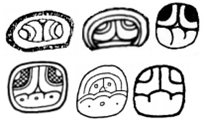
![]()

![]()
![]()
![]()
K&L.p10.#1 TOK.p15.r5.c1 BMM9.p11.r3.c2 25EMC.pdfp29.#5.1 = JM.p35.#3 25EMC.pdfp29.#5.2&4
AK’AB AK’AB AK’AB AK’AB AK’AB AK’AB
25EMC.pdfp29.#5.3 = K&L.p10.#1.4
![]()


MHD.SM8 MHD (Stuart) MHD (Stuart)
PAL Temple 19 Platform A1 PNG Stela 10 A1
AK’AB ISIG[AK’AB] ISIG[AK’AB]
· No glyphs given in K&H (except as a day name).
· AT-YT2021-lecture4.t0:39:42-43:39 is a whole section devoted to “markers” – glyphic elements used in the iconography to indicate that the marked object, animal, or person has a certain property. In particular 41:13-42:23 discusses how the darkness element marks nocturnal animals or dark objects, animals, or people: Dark and nocturnal creatures are also marked with the sign for darkness ak'ab. And it's interesting that it extends to creatures which are mostly nocturnal, but also creatures which spend most of the time underground, so certain insects for example. So most of the rodents are obviously nocturnal. Fireflies, as in the image that you see in the lower left corner; bats, jaguars, they're all marked with this property qualifier. And then some objects are marked as especially black [or] dark. So obsidian, for example – it's not necessarily nocturnal, but it is black, it is dark. And so obsidian blades may be recognized: in writing where it's just a syllabogram or logogram ta or taaj "obsidian", but also in iconography – as something marked with this darkness symbol, in the same way that nocturnal animals or underground animals are marked.
· There is a head variant of AK’AB, but it’s not very common:
o MHD assigns it the 3-character code SM8.
o A search in MHD on “blcodes contains SM8” produces 12 hits:
§ 7 infixed in ISIG.
§ 2 (perhaps 3) in yak’abil = “the darkness of”.
§ 1 in an actual Tzolk’in date.
Not that many of these head variants have a very clear (conventional) “AK’AB” infixed in the top part of the head. The others are probably read as AK’AB on the basis of context, rather than actually being able to see it from the glyph itself.
o So, while it doesn’t occur very often, one of the “common” contexts it’s found in is infixed in the ISIG, as the patron of the Haab month Mol (though “regular” AK’ABs are more common). Two examples of the head variant are given above – one of which has an infixed (conventional) “AK’AB”, the other of which doesn’t.